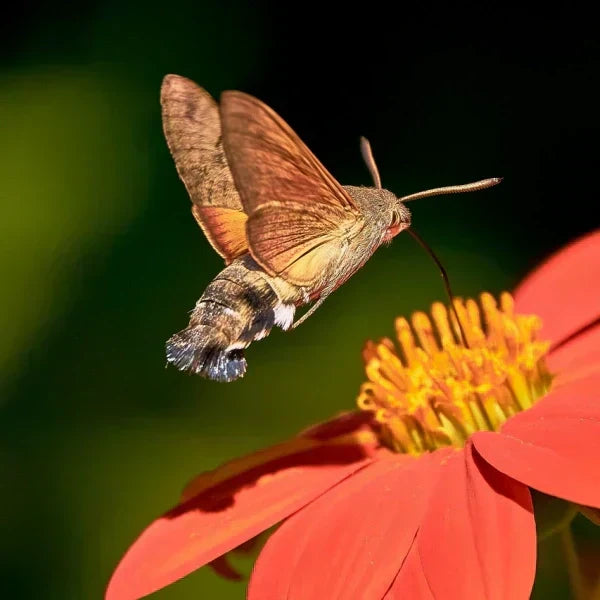Introduction
"Look! Up in the garden! It's a bird! It's a hummingbird!" …But hold up. What are those antennae doing there? The soft hum, the stunning way it hovers in midair, it all fits. And then you blink twice at the antennas. That's when reality slaps you: this isn't a bird, but a hummingbird hawk-moth.
There are so many questions. Why would a moth fly like a hummingbird? How does an insect fly this fast and with precise control? And why does it look nothing like any of the fuzzy, evening-flying moths we are familiar with? The more you look, the more fascinating it becomes.
In this article, we're diving into what makes the hummingbird hawk-moth so remarkable. We'll explore how its body is engineered for hovering. How its life cycle unfolds, where it lives, what it eats, and how climate change is shaping its future.

Hummingbird Hawk-Moth Image by Jürgen from Pixabay; Hummingbird Photo by Dulcey Lima on Unsplash
Etymology and Taxonomy
The hummingbird hawk-moth's scientific name is Macroglossum stellatarum, named by Carl Linnaeus in 1758. It belongs to the Sphingidae family of over 1,400 species of hawk moths or sphinx moths. As opposed to the majority of moths, many hawk moths, like Macroglossum, are active during the day. They also possess the ability to hover with precision.
The "hawk-moth" name reflects its powerful, rapid flight, similar to the swooping of a hawk. The "hummingbird" name is the product of convergent evolution. They hop from flower to flower, making a humming sound and feeding with a long tongue, just like a hummingbird. Its genus name, Macroglossum, comes from the Greek words "makros" (long) and "glossa" (tongue), for its long proboscis.

The hummingbird hawk-moth hovers like a tiny bird as it feeds on nectar in daylight.
Image by Jürgen from Pixabay
The Macroglossum stellatarum is not the only hummingbird-like moth. In North America, there are other Hemaris species, such as Hemaris thysbe and H. diffinis, that also resemble hummingbirds. However, they have transparent wings and hairy bodies. This moth has also been the subject of myth and superstition throughout history. In some European places, it is considered a sign of good luck. In World War II, troops documented clouds of them on D-Day, calling them hope symbols.

Hemaris thysbe photo by Judy Gallagher, via Wikimedia Commons, licensed under CC BY 2.0.
Physical Characteristics of Hummingbird Hawk-Moth
The humming hawk-moth is tiny but highly specialized. It has a wingspan of 40–45 mm and a body length of 3 cm, with the perfect power-to-weight ratio. Its brown forewings have dark, wavy markings for camouflage. Its orange hindwings, edged in black, flash like signal flags when it flies. Its fan-shaped tail, made up of stiff hair-like scales, is a built-in stabilizer. With this feature, the moth can change direction with fine precision.
One of their most remarkable feature is their 25–28 mm proboscis, which is nearly as long as their own body. When at rest, the proboscis is curled up. However, it uncurls to reach deep inside tubular flowers inaccessible to most insects. To support this feeding mechanism, the moth has densely packed flight muscles. They also have an efficient circulatory system that rapidly brings oxygen to their tissues. It's this body structure that enables them to have rapid wing movement without tearing or fatigue.
The humming hawk-moth feeds with a proboscis that curls and extends like a tiny straw.
But flying isn't just about power; it also involves control. The moth has trichromatic vision, perceiving ultraviolet, blue, and green light. They are able to locate nectar-rich flowers even in sunlight. Their eyes are so sensitive that they can detect tiny colour changes. Johnston's organs at the base of every antenna detect wing location and airflow, giving the moth constant feedback. Combined with elastic wings and rapid neural response, these traits enable them to fly with bird-like accuracy.

Flight Behavior and Hovering Skills
While other moths lurk in the dark, the hummingbird hawk-moth flies openly in the daylight. They remain functional during dawn, twilight, and even light rain, exhibiting superb control in weather that affects other insects. Its wings beat 70–85 times per second. The soft humming sound tends to make humans mistakenly identify them as a hummingbird. Unlike flying insects, they literally hover. They repeatedly change wing angles and body position in order to stay perfectly still in the air.
This moth is among a select group of insects that fly in any direction. They also possess excellent spatial memory and trap lines as they return to the same flower each day. All of this aerial display comes at a high physiological cost. Hovering is able to raise its thorax temperature above 45°C (113°F). In contrast, its metabolism can increase to around 100 times its resting rate. The moth must feed continuously and frugally to survive. They shed excess heat continuously in order to prevent muscle damage and sustain long periods of flight.

Hummingbird hawk-moth nectaring on Buddleja (5 frames per second)
Life Cycle: From Egg to Adult Hummingbird Hawk-Moth
The hummingbird hawk-moth starts life as a small, pale-green egg deposited on the leaves or buds of its host plants. The egg is so well camouflaged that it appears to be part of the plant, sheltering it from predators. Females are selective and opt for sunny, protected positions so the eggs remain warm and develop more quickly. A female lays up to 200 eggs. Within 6–8 days, a ravenous larva emerges and starts feeding immediately.
Most growth occurs during the caterpillar stage. The larva is first bright yellow but changes rapidly into a green color with diagonal white stripes. This change allows them to blend with the plant's green leaves. Its most distinctive feature is the horned tail. It changes from red to blue with a tip of orange as it matures. In contrast to most caterpillars that stay hidden, they eat openly in sunlight, using heat to speed digestion. It moults five times before dropping to the ground to become a pupa.
The moth forms under leaf cover or shallow soil. The brown pupa takes the shape of its adult proboscis. The adult will emerge in about two weeks and will fly in mere minutes. In warm regions, this species can produce two to four generations within a year.

Pupa (2 weeks old) of hummingbird hawk photo by Stavast22, via Wikimedia Commons, licensed under CC BY-SA 4.0.
Habitat, Range, and Migration
The hummingbird hawk-moth is incredibly adaptable and can be seen in gardens, meadows, woodland margins, and open parks. It is also seen in hedgerows, arable land, stone slopes, and even along seafronts. They have a preference for warm, open areas since both the adult and caterpillar derive energy from sunlight. Females oviposit on host plants like bedstraws, wild madder, and red valerian. These are perfect food sources for larval development.
This moth is indigenous to Europe, North Africa, and Asia, from Portugal to Japan. It hardly remains in one place for more than a short while, though. The hummingbird hawk-moth is a powerful migrant and will travel up to hundreds of miles in a season. It migrates north into the United Kingdom, Scandinavia, and even Russia each year. In warmer Europe, it can have three or more generations, while cooler areas typically support one.

By User: Carstor and User: Kulac, via Wikimedia Commons, Public Domain.
Feeding and Ecological Role
The hummingbird hawk-moth lives at full throttle, powered by a high-energy metabolism that requires constant refueling. It drinks nectar only and never bites or harms plants. Adults feed on flowers with nectar, such as honeysuckle, buddleia, verbena, jasmine, lilac, and phlox. They especially prefer tubular, elongated flowers whose length is compatible with their proboscis. The hummingbird hawk-moth is active when other pollinators are resting.
The moth is also very smart. They visit the same flowers on a daily basis, and this is referred to as trap-lining. This strategy allows them to conserve sufficient energy. Its nectar-feeding lifestyle makes it a valuable pollinator. With its long proboscis, it is able to reach deep-tubed flowers inaccessible to bees.

Photo by Yusuf Akgul, via Wikimedia Commons, licensed under CC BY-SA 3.0.
Threats and Conservation
The hummingbird hawk-moth is not globally threatened, but scientists have reported declines in some areas. Its worst enemies are habitat loss, reduced floral diversity, and the use of pesticides, impacting caterpillars and nectar. Because hummingbird hawk-moths depend on open, hot ground, extreme weather is deadly. Heatwaves and drought dry up host plants, and heavy rain erodes the larvae population. Climate change has allowed the moth to expand northward, but this is a double-edged sword if the habitat becomes unstable.
Multiple organisations are trying to protect pollinator habitats. Buglife and the European Pollinator HUB restore wildflower habitats and campaign for public support. Even gardeners can contribute to conservation. They do this by sowing native nectar plants and avoiding the use of pesticides.

Conclusion
The first time you see a hummingbird hawk-moth, your mind tricks you into thinking it's a hummingbird. They hover in the air, produce a humming sound, and sip nectar with remarkable elegance. But now we know the truth, they are not just imitating birds. They evolved to do it exceptionally well. This tiny insect is not only a marvel. They are a pollinator and an indicator that even the tiniest of creatures can impact an entire ecosystem.
If you want to welcome these amazing pollinators—and real hummingbirds too—try creating a more inviting space with our tips in Attract Birds to Your Backyard.

Image by Erik Karits from Pixabay
FAQs About Hummingbird Hawk-Moth
Do hummingbird hawk-moths go to hummingbird feeders?
Yes, hummingbird moths do eat from hummingbird feeders because they are attracted to the sugar water, just as they are to the nectar in flowers. These moths can hover and drink using their long proboscis, similar to how hummingbirds feed, which is why they are often mistaken for birds.
Are the hummingbird hawk-moths real or a myth?
Hummingbird moths are completely real. Their rapid wing beats and hovering flight make them look like tiny birds, which often leads people to think the photos are fake. In fact, they belong to the Sphingidae family of moths, and their bird-like flight helps them feed efficiently from flowers while avoiding predators.
Do hummingbird hawk-moths bite or sting?
No. They don't sting, bite, or harm humans or animals. They simply sip nectar. Adults feed only on nectar from flowers using their long proboscis. Their harmless nature makes them a welcome visitor to gardens and natural areas.
How long does the hummingbird hawk-moth live?
Adults live 2–3 weeks, but in the tropics, they can live for several months and even overwinter. Their full life cycle, from egg to caterpillar to adult moth, usually spans a few months, with caterpillars feeding on host plants before pupating.
Are hummingbird hawk-moths good or bad?
Their presence in gardens and natural areas across North America not only adds a touch of wonder but also significantly benefits your plants. By visiting flowers like honeysuckle, butterfly bush, and petunia, these moths help pollinate plants and contribute to the health of your garden's ecosystem.
What attracts hummingbird hawk moths?
Hummingbird hawk-moths are drawn to sweet-smelling, trumpet-shaped flowers that give easy access to nectar. Popular choices include honeysuckle, bee balm, moonflower, jasmine, and verbena. Light-colored or white flowers stand out at dusk when these moths are active, and a sunny garden with nectar-rich blooms will help attract them.




Leave a comment
All comments are moderated before being published.
This site is protected by hCaptcha and the hCaptcha Privacy Policy and Terms of Service apply.